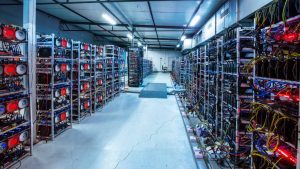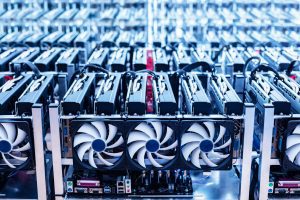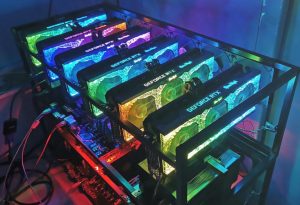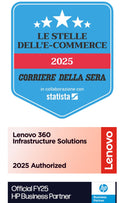Mining and cryptocurrencies, the investment of the future draws on IT
Mining and cryptocurrencies are two terms that have entered the Italian dictionary recently, but with great emphasis. But what do these two terms consist of? How do they relate to each other? And what is their relationship with computing, energy consumption and the shortage of some video cards?
Let's look at it point by point, starting from the definition of the two terms.
Cryptocurrency

Also known as cryptocurrencies or cryptocurrencies, this term indicates the English equivalent cryptocurrency. This name normally refers to a digital currency whose value is based on cryptography and a complicated calculation process. The peculiarity of crypto is that of the creation, conservation and validation of the system underlying it, on users' computers, through a technology called peer-to-peer (p2p). The advantage of these currencies is that they are not subject to a central authority (such as the Bank of Italy) that controls them, therefore making them freer and more democratic, but also more risky. Traditional cryptocurrencies are generated by an activity called "mining".
Mining
Mining is also a term of English origin, whose form derives from "to mine", i.e. to extract. So with this action we are going to identify the process of extracting digital coins. A complex but fascinating process, possible (theoretically) for anyone with a computer with a certain computing capacity connected to the Internet.
Crypto mining therefore resembles the process of searching for gold that was so common in the 19th century.
 Mining and cryptocurrencies
Mining and cryptocurrencies
As indicated above, there is no state or supranational bank that manages and "prints" cryptocurrencies. The same are in fact created through complex algorithmic calculations based on a certain volume of transactions recorded according to a code called "Hash transaction".
Mining is a validation process for all cryptocurrencies that use the process called “Proof of Work” ; the most famous of these is obviously Bitcoin, but obviously not the only one.
The mining activity, carried out by the "miner", is fundamental to the concept of the blockchain, the basis of these digital currencies, but not only. Blockchain is, in short, the creation of a chain of blocks, to which all miners contribute in two ways.
The block contains all the transactions that can be recorded in it. Before this block is connected to the existing chain, it must be created and validated.
The work of miners is concentrated in these two activities, and they are rewarded for their processing work through the creation of cryptocurrencies. The same will then be assigned to the "miner".
To ensure that this block is added to the chain of previous blocks, we wrote that it must be "closed" or "completed" using a particular unique code, which can only be found by making numerous attempts.
These attempts are the processing and calculations performed by a computer, in an activity that becomes increasingly complicated, time-consuming and expensive as the number of existing cryptocurrencies and the blockchain chain grows longer.
Mining and cryptocurrencies, history
Focusing on the history of Bitcoin, a true crypto symbol of mining, we must go back to 2008 to have a precise timetable of its progress.
On that date, on a specialized forum, a user called Satoshi Nakamoto (of whom even today it is not known whether he is a real person, alias or name of a group of people) announces the creation of a crypto, Bitcoin , which will free up transactions economic from the control and supervision of central governments.
This is a revolution in which many "early adopters" participate; in fact, at the beginning, precisely because of the logic behind the cryptocurrency, creating it is not complicated. On the other hand, the value of the Bitcoin given was still minimal.
Over the years, with each addition of blocks to the blockchain, the creation process has become a little more complex, time-consuming and energy-intensive.
If in 2009 you could "mine" a Bitcoin or parts of it with a normal computer and earn an expense-income ratio, today everything is much more complicated.
Mining and earning
If at the beginning mining a Bitcoin or parts of it was a simple activity, today this operation is increasingly complicated. Indeed:
If this therefore led to advantages for Bitcoin owners (who found themselves possessing great value in terms of trading), for those who "create Bitcoins" these became further obstacles.
Today, mining Bitcoin with a standard machine is a mission impossible. For this reason, those who continue to mine Bitcoin have had to organize themselves differently over time.
Mining and cryptocurrency hardware
The growing difficulty in developing the algorithms that reward the granting of cryptocurrencies has led to important technological changes over time.
2008-09
For the first Bitcoin miners, the processing and extraction work was "easy", in fact a standard computer was sufficient, perhaps equipped with a standard multi-core CPU to produce Bitcoin, but this package will not last long...
2010
The turning point year. In this year a user of the Bitcoin community publicly releases the code for mining Bitcoin using GPUs.
This step will revolutionize the logic of Bitcoin's creation, taking away a bit of "poetry" and "democracy" from it and making it become a mere business. There will be many who will lash out against this technological innovation, including Satoshi Nakamoto himself, but innovation will continue anyway, regardless of the indications of Bitcoin "purists".
”We should have a gentleman's agreement to postpone the GPU arms race for as long as possible for the good of the network. It's much easier to get new users if they don't have to worry about GPU drivers and compatibility. It's cool how anyone with just a CPU can compete pretty fairly right now.”
Satoshi Nakamoto.
Obviously the majority of users did not pay much attention to this "ethical" warning and moved the production of Bitcoin from the CPU to the GPU. This choice caused various effects:
2011-12 
The boom in video cards alone and in the exploitation of the GPU for the resolution of these complex calculations lasted relatively short.
In fact, already in 2011 the mere presence of a specialized and dedicated video card was no longer sufficient to have adequate computing capacity and consequently profits.
This will lead to the development of a new technology, which will fully take hold from 2015.
2015-16
The protagonists of this period are FPGAs. FPGA is the acronym for Field Programmable Gate Array, or in Italian Field Programmable Gate Array.
FPGAs are simple semiconductor devices that can be quickly programmed and reprogrammed. This therefore leads those who do "mining" to be able to efficiently reallocate their hardware, in order to "correct" it based on the needs dictated by the algorithm, the code and the most convenient currency to mine at that moment.
However, even FPGAs are not the definitive solution.
ASIC
The development of FPGAs has in fact led to a further evolution, made by specific processors called ASICs. The main characteristic of ASICs is that they can give the best result between available computing power and energy consumption.
The continuous evolution of processors and mining systems has therefore led a democratic and widespread hobby to become a real industry, with dedicated factories located in strategic areas of the world.
 Do ASICs free up video cards?
Do ASICs free up video cards?
The widespread adoption of ASIC systems has led to a slight decrease in interest in video cards. A minimal drop in demand, given that for some crypto coins, the use of the video card is still profitable (for example Ethereum).
This therefore led to a drop in the prices of video cards, which however still remains high compared to the "pre-mining" period.
Mining and cryptocurrencies and the impact on the environment
The high computing capacity required and the need for specialized cooling systems make mining today a very expensive activity to create and maintain. From a hardware point of view, starting a mining activity today means being able to invest thousands of euros in a top-level IT structure, specifically dedicated for this purpose.
A significant energy consumption must then be added to the initial purchase. This leads to very high costs of purchasing electricity, with the creation of these factories in places where the cost is reduced or where there is the possibility of exploiting independent energy production systems.
The "mining" factories today are mostly concentrated in "tax havens" from the point of view of the energy cost of electricity; in fact we find them in Iceland, Russia, South America, China and the northern part of Eastern Europe.
Currently, energy consumption and the consequent "production of pollution" of mining is one of the most criticized consequences of mining. For example, in 2020, energy consumption from mining in Iceland exceeded that of all its private and industrial activities.
This will therefore lead to political consequences and impositions, such as those that Europe is considering. An organization that is studying an ad hoc taxation of electricity used for mining or even the banning of this activity on our continent.
Mining with a 386
In order to demonstrate the amount of processing capacity needed and the high demands of mining, a few months ago an internet user carried out a curious experiment. He got a 30 year old laptop, an old Toshiba 386. For the same he created code that would allow the CPU to process blockchain requests. The result once again demonstrated the computing capacity currently required for mining; in fact, to "mine" the equivalent of a dollar of value using such hardware would take 584 million years!
Mining strategies
Without going into extreme cases like the one reported above, for those interested in mining, there are currently two possible strategies available. Each of them obviously requires a good economic availability to start, a clear idea of what it wants to do and a good confidence that the crypto market and their value is not just a "speculative bubble".
Here they are:
In both cases, long-term evaluations are necessary. Correct choices regarding the type of hardware and related suppliers and continuous control of energy costs are also necessary.
All this makes mining less and less a private activity and more and more a "business" activity delegated to a few groups of entrepreneurs.
For the "normal" user interested in cryptocurrencies, there is now only the possibility of trading on them. For an activity whose objective is to earn on the differential between the purchase and sale price.
Mining and cryptocurrencies, is it still worth it? 
The closer we get to running out of coins available to mine, the greater the difficulty of achieving an economic return that exceeds the costs of the activity. This leads mining to become increasingly specialized. Not all evil has a silver lining. This specialization has in fact led to freeing up resources, availability and deflating the prices of "standard" devices which for a short period were used and requested in a "massive" way by those who mine.








